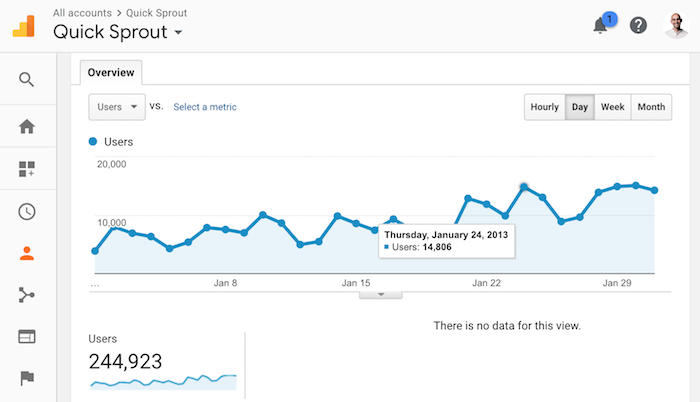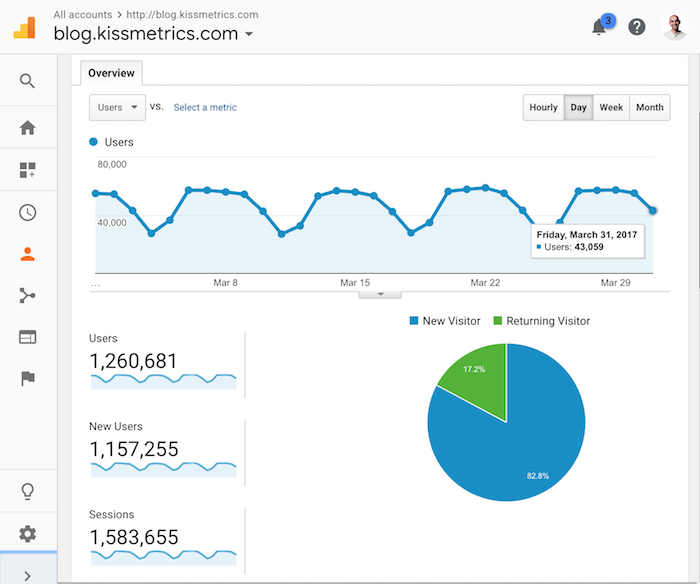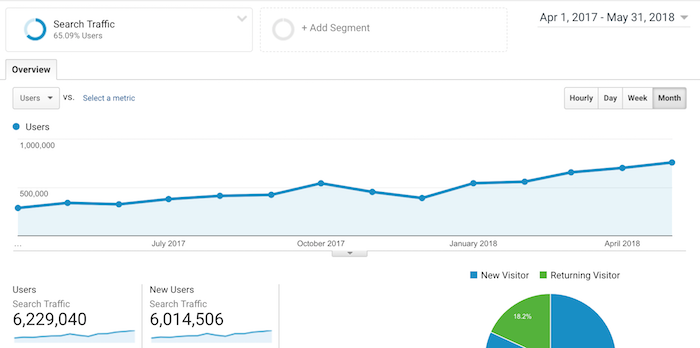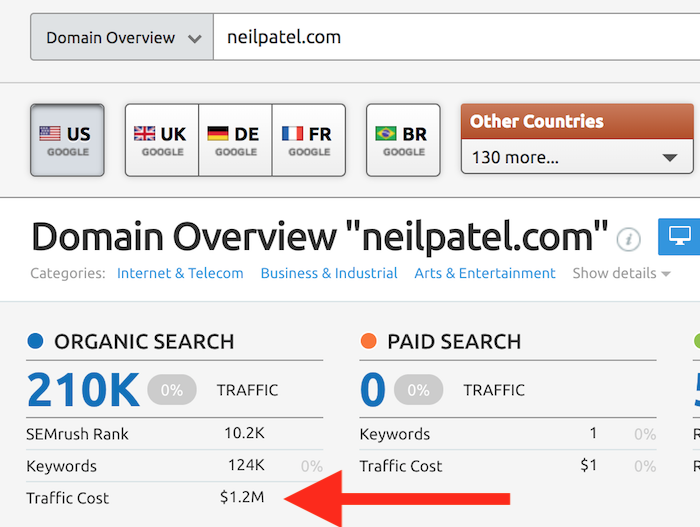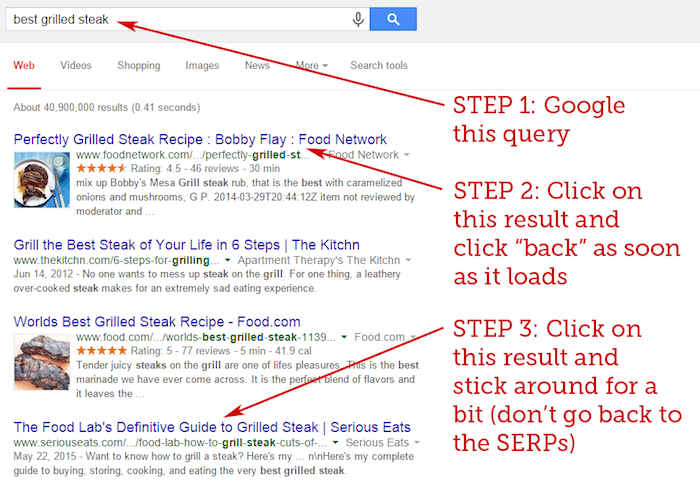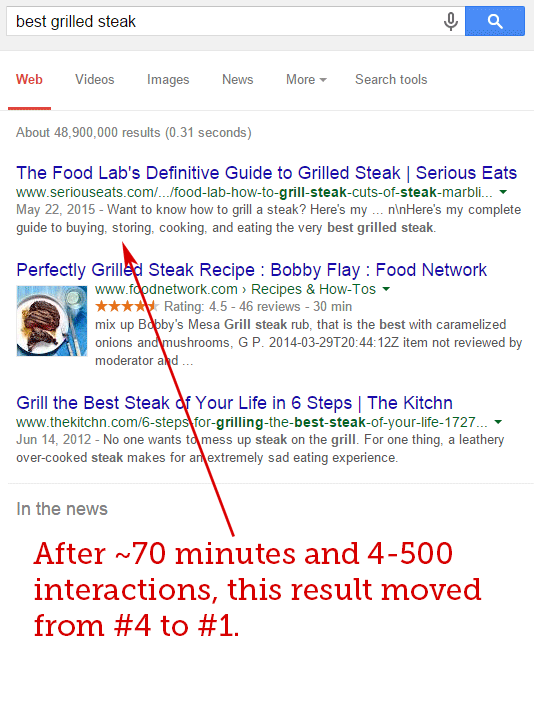Transcript of How Reducing Friction Increases Revenue written by John Jantsch read more at Duct Tape Marketing
Back to Podcast
Transcript
This transcript is sponsored by our transcript partner – Rev – Get $10 off your first order
 John Jantsch: This episode of the Duct Tape Marketing Podcast is brought to you by SEMrush. It is our go-to SEO tool for doing audits, for tracking position and ranking, for really getting ideas on how to get more organic traffic for our clients competitive intelligence, back links and things like that. All the important SEO tools that you need for paid traffic, social media, PR, and of course SEO. Check it out at semrush.com/partner/ducttapemarketing, and we’ll have that in the show notes.
John Jantsch: This episode of the Duct Tape Marketing Podcast is brought to you by SEMrush. It is our go-to SEO tool for doing audits, for tracking position and ranking, for really getting ideas on how to get more organic traffic for our clients competitive intelligence, back links and things like that. All the important SEO tools that you need for paid traffic, social media, PR, and of course SEO. Check it out at semrush.com/partner/ducttapemarketing, and we’ll have that in the show notes.
John Jantsch: Hello and welcome to another episode of the duct tape marketing podcast. This is John Jantsch and my guest today is Roger Dooley. He is the founder of Dooley Direct. He’s an author and keynote speaker and he’s got a new book called Friction: The Untapped Force That Can be Your Most Powerful Advantage. So Roger, thanks for joining me.
Roger Dooley: Well, thanks for having me on, John. I’m excited.
John Jantsch: Let’s start with friction. The word friction, I mean for a lot of people that’s kind of a bad thing. I mean, friction in science is … causes drag, friction in business makes it hard to buy. You’re proposing that it is somehow and advantage.
Roger Dooley: Well if you … it is usually a bad thing, but that means that if you can eliminate it, you will have an advantage over your competition. I mean if you look at what Amazon has accomplished in the last 20 years, much of that has been by reducing friction. Back in 1997, Jeff Bezos was talking about frictionless shopping when most companies were just thinking about getting serious about being online. And throughout the years he’s made that just a point of relentless emphasis. Even things like packaging. About 10 years ago they saw the customers were struggling with these packages. Like if you go to Walmart, buy a product, it’s probably in one of these plastic blister packs. But you see the product and they look nice, they prevent theft because they’re hard to put in your pocket and walk away with, but they’re difficult to open. You may need tools, you may injure yourself by stabbing yourself with sharp plastic. And so they said, “Hey, we can eliminate that.” And they created frustration free packaging. And not only did people like the packaging, the reviews on those products improved. They had 73% fewer negative comments just from that change in packaging. And so eliminating friction can be a big competitive advantage. It isn’t just big companies because often big companies are the slowest to respond. So a smaller company that sees how they can make things a little bit easier for their customers can get that advantage.
John Jantsch: Yeah. And I must admit that my wife will be reading a magazine and she’ll say, “We should get this and,” and it says the website and all that stuff, and I go straight to Amazon and see if they have it because I know it’s going to be really easy for me to get it.
Roger Dooley: Well you and me both. John, just a few years ago, my loyalty to Amazon was tested because up to that point, in Texas, they were not charging sales tax. Then they worked a deal with the state where they would be charging sales tax, which meant that all of my Amazon purchases immediately had an 8% price increase. And I assumed that my behavior would change because of that. In fact, it changed almost not at all. And because of what you’re saying. It’s just so easy, why would I want to go someplace else, deal with setting up an account to have some sort of uncertain shipping process where they say it’s going to be seven to 10 days and … when I know with one click I can get it from Amazon and it’s going to be my doorstep 48 hours later without fail.
John Jantsch: So you mentioned the bigger companies, it’s harder. Some of that can just be the practical nature of making change is harder period. But do you think it has anything to do with that a lot of times friction is felt by a customer, but not necessarily expressed? They may not even realize that their shopping cart is hard to operate.
Roger Dooley: Right. Well, many times customers can’t articulate that there is a problem. It’s only when they see somebody doing it better. I mean, look at the taxi industry. For pretty much our entire lives, we dealt with taxis as something that was a pretty good way to get around, generally better than the bus or the subway and worked reasonably well. And it wasn’t until Uber came along and showed us how every element of that process was full of friction from getting the cab in the first place to getting out of it and paying. They eliminated all that and suddenly it’s like, wow, none of us really saw that before, but now we could. So yeah, I think what businesses have to do, whether they’re large or small, is kind of look at their processes from a third party point of view. Instead of saying, “Well, this is how it’s always been done,” or “This is how our competitors do it and we’re actually a little bit better than our competitors,” for one, you have to compare yourself to Amazon and to Uber and say, “Okay, is my experience as good as theirs? And if not, can I move my experience in that direction?”
Roger Dooley: So it’s just important to focus and also to observe customers. I bet you’ve had the same happen, John. You’re on a website or you’re trying to accomplish something and you just can’t figure out what to do. And you’re wondering, did the people who created this website or this app ever actually watch somebody try and go through it for the first time? Because you’re perplexed and you’re struggling and you’re clicking stuff. And I think the answer is in many cases, they have not watched users go through it. They have an idea of what the users or customers want, or will do, or how they’ll behave, but they haven’t actually watched them doing it. And that’s so critical.
John Jantsch: And I think the one thing that a lot of people underestimate too is that … if you used the taxi example. I mean you and I just tolerated it. We didn’t like it, but we didn’t necessarily think we had a choice or that it was even a problem per se. It was just the way the world is. And I think when you watch, what happens a lot of times is that next generation comes along and goes, “This is nuts.” We’ve been doing it, so that’s all we know. But they’re new to it and all of a sudden they’re like, “Why would anybody do this?” I have millennial age children that are so funny to watch how little they will tolerate from a website because they just, that’s not how they feel like the world should work. And they’ll go find somebody who gets it. I mean, because they don’t have that same sort of loyalty, I guess is what I’m getting at.
Roger Dooley: Right. Well, it’s not even so much loyalty. It’s that they realize how simple and powerful experiences can be. I think a good example of businesses that really don’t get it are cable providers. I have an internet cable provider and I have a satellite TV provider and they both kind of fall into that category of not getting it, making their experience really high friction. On Amazon, I can look at anything I bought in, I don’t know, 10 years, 12 years, beats me. I can go back as long as I want and see every order I’ve placed. On my Internet provider, I can only go back six months. So when I go to do my tax and say, “Okay, well I need those bills for that purpose,” then it’s not there. And you say, well why would a business design an interface that would only let me look at the last six months? Now that makes no sense. But unfortunately businesses say, “Well, hey, why would a customer want that, or we’ve done it this way, it’s been fine.” And they don’t have necessarily anybody that’s forcing them to do it any better.
John Jantsch: Yeah. And that’s actually a great feature of Amazon though. Have you ever done this? You buy a book and they go, “Whoa, you know, you bought this book two years ago,” and I go, “Oh, okay. So it’s on my Kindle. Nevermind.”
Roger Dooley: Yes. I personally have never had that experience, John. But I have heard from people who have. It happens to me all the time saying, “Ah, book looks interesting,” and “Oh, damn, I bought that, I’ve got it on my shelf somewhere. I better go find it.” Yeah, it’s great. And I think that is an example too of a business that is putting its customers in the forefront because there are certainly some businesses out there would say, “Ha, that jerk just bought that for the second time.” Where Amazon wants you to have a good experience and they know that eventually you might discover that you bought it once, you already had it, and either you’re going to return it or you’re going to feel stupid because you have two copies now and they help you prevent that.
John Jantsch: And I think you just touched on where this starts, right? It’s not just about how can we make this website faster, easier to use. I mean it really kind of starts with what you just said. How can we make sure that our customers are having a great experience? I mean that’s what sort of turns you into the detective to go looking for this stuff, isn’t it?
Roger Dooley: Yeah. And I think just jumping back to taxis, if somebody had just, say taken a video of the taxi experience, you could look at the particularly, I don’t know, I’m sure you get to Europe occasionally and like to pay for taxis by credit card there. If I have to take a taxi and … because Uber isn’t available because it’s illegal or something. And inevitably what you see is the driver first saying the machine’s broken. And then you say, “No, I don’t have any cash.” So you got to use that. And so, okay, they reach under the seat, they pull out this a clunky machine trying to establish an Internet connection, get your card, wait for the thing to print out. And then they’ve got to print out and sign it and they’ve got to reenter it. It’s this horrible process that takes minutes. And if someone just looked at that, they could say, “Well, can I imagine a way in a perfect universe where I could eliminate this?” And it wouldn’t be that difficult to come up with multiple ways of eliminating that process, but it took this really disruptive company to come along and actually do it.
John Jantsch: And I suspect because you pay attention to this stuff that I can envision you across the counter from a young clerk who has a very … a process that is riddled with friction and doesn’t make any sense to anybody. And you point it out to them and they say, “Well that’s the way we do it here. Or that’s how we’ve always done it here.”
Roger Dooley: Yeah. Or they say, “Yeah, no kidding. We’ve complained about this, but they won’t do anything about it.” More often than not, people inside the company can identify it as friction, but they are unable to get it fixed. And to me the important thing is that businesses develop a friction aware culture so that their employees are sensitized to look forward in the customer experience. But even in their own experience, because oh, there is a huge amount of money, in fact there was a Harvard Business Review article that estimated that $3 trillion a year is wasted in US businesses by what they called organizational drag. Used the word drag just in the intro. And organizational drag is what they call all the time that’s wasted by bad processes, dealing with email that you shouldn’t have to deal with, meetings that served no purpose, or all this waste of time in organizations is a $3 trillion problem. And so businesses that develop this friction awareness will not only improve their customer experience, but they’ll improve their internal experience. And that’s great because the team members themselves do not enjoy wasting your time. They’ll be more engaged if they feel they’re working on stuff that is important or is helping a customer, as opposed to doing stuff that is really serving no purpose other than the fact that they’ve got to do it.
John Jantsch: Yeah, I read a survey, this is going back at least a decade, maybe longer, and it was a giant Gallup survey talking about what made people happy at work. And you would think it would be that they felt challenged and they were paid well, and the number one thing was that they had the tools that allowed them to do the work effectively. So essentially, processes and equipment, and tools, and things are of part of that that causes friction, isn’t it?
Roger Dooley: Yeah. And there’s a lot of work that’s been done on work and motivation and having that work directed in a productive creative way is one key metric. Dan Ariely he did some really interesting work and wrote a short book called Payoff about that, but where they would have people assemble Legos under different conditions. In some cases, immediately after the person assembled the Lego, the experimenter would tear it apart in throw the pieces in the box. Needless to say, the people that had that experience were much less motivated to build more Legos even though there were being paid the same as folks where their creation was not destroyed.
John Jantsch: So you mentioned this friction awareness. I’m just trying to envision, how does, where does somebody go looking for it? Where does it hide, how did you … if I’m listening to this and I think, “Okay, I’m not aware of huge friction,” where do … how do I find it? How do I create this awareness culture?
Roger Dooley: Well, by reading the book for one, but no seriously John. I think that just looking for examples of it, becoming aware of it. It’s sort of like if there’s a background hum noise, which hopefully there isn’t in this recording, but you generally might not be aware of it. But if you listen for that background, how many say, “Oh yeah, okay it’s there.” And friction is kind of the same way because we become just sort of used to it, like that taxi experience and every other experience like that. But if we start looking at it from a more of an absolute point of view and imagining better ways, then we start seeing it. I found that just if I do a talk where I spend maybe 30 or 50 minutes talking about friction, just that exposure will get people for the rest of the day yelling friction when they encounter some difficulty in the hotel or the conference center, something where there’s a line or some form they have to fill out.
Roger Dooley: So it’s really just sort of sensitizing yourself and then once you start seeing it, it’s pretty hard to stop seeing it. Which is in some ways, is kind of bad because you cannot cure all the friction that you’re going to experience, especially when you’re simply the customer and someone else is controlling that. And it can get you, gets me at least, a little bit cranky at times.
John Jantsch: There’s a line from The Scarlet Letter by Nathaniel Hawthorne. I’m actually doing … my next project involves some of that literature. So that’s-
Roger Dooley: I was [crosstalk] going to say this is taken really literary turn [crosstalk]
John Jantsch: Yeah, I was going to say that that’s why this is right at hand and it was, “She had not known the wait until she felt the freedom.” And I think that really goes very directly to this. A lot of times we don’t realize how much we’re way down until we find this better way. And we were like, “Holy crap.”
Roger Dooley: Wow. I would have put that in the book, had I known that quote at the time, John, so I may still have to use that somehow. So thank you for that.
John Jantsch: And you talked about this thing actually called invisible friction.
Roger Dooley: Indeed. Not … to some degree, all friction can be a little bit invisible if we’re not looking for it. But there is another kind of cognitive friction where we … there’s no rational reason why something should be higher in friction, but it’s all in our brains. And it has to do with a concept called cognitive fluency, how easy it is for our brains to process something. And this affects our behavior in a few ways. If something is difficult to say or read, it seems more dangerous and risky. So when scientists ask people to rate the amusement park rides for how dangerous they were or risky, if they had a hard to say name, the exact same ride description was rated as to being more dangerous. Same thing for prescription drugs. Drugs that were hard to say were seen as more dangerous. But where the friction comes into play is that if something is hard for us to process, it seems more difficult.
Roger Dooley: There is another research project that found people were less likely to follow important medical instructions, now imagine that, medical instructions that are important for their health and perhaps their life, if those instructions were in a hard to read font and it wasn’t that they were so difficult that it was impossible to read. It’s just that when things are hard for our brains to process, even a little bit harder, they seem a little bit more difficult. At the University of Minnesota, they ran this great experiment that asked people how long it would take to perform a simple exercise. It just gave them two short sentences. Exact same text for two groups. One group saw it in a simple arial san serif font, so a very easy to read font. The second group saw the exact same instructions in a slightly harder to read brushy font. Still perfectly legible. You’d have no problem reading it. But the first group that saw it in the simple font said it would take eight minutes to do, the second group said it would take 15 minutes.
Roger Dooley: So what was happening there was that the difficulty in processing that information, the difficulty in reading, translated into difficulty in doing. And that’s really an important message for anybody who is designing websites or apps or print material. Anytime you’re asking somebody to do something, you want to make sure that those instructions are short, concise, easy to read, black on white, or something. And use the simplest font possible because the more difficult it is to read, the harder whatever it is you want them to do is going to seem and the less likely they’ll be to do it.
John Jantsch: Well, I know from a marketing standpoint, it’s pretty accepted logic that while you would think giving people lots of choices would actually make their decision easier, it really creates friction that you’re sometimes better off saying, “You want A or B?” And that’s about it.
Roger Dooley: Yeah, well, Barry Schwartz wrote an entire book called The Paradox of Choice that kind of zoomed in on that issue that in many cases, not in all cases, but in many cases, the more choice you have, the less likely you are to actually make a decision. And it varies, but there’s ways of dealing with that too. One is to just limit the number of choices. If you only need three plans, don’t offer people seven plans, because that may kick them into sort of an analytical mode where they end up making no decision at all. Guiding them to the most popular of the three plans is a great way to show, “Okay, there’s good, better, and best. Almost everybody chooses better.” At that point, that’s a really easy decision for most people to make. But if you’ve got a seven plans and it’s some have different features and they’re overlapping and that’s where it gets confusing.
Roger Dooley: So, but now Amazon has unlimited choice. If you pick any product, they probably carry just about every version of that product that’s available on the planet. But the way they help their customers is by providing a whole series of screens and filters and queues. So first of all, they will rank the products and the way they think that best fits your search. They will show you, “This one is a best seller.” They will show you, “This one is best rated.” They’ll show you that it’s got four and a half stars from 2000 reviews. And all of these things are cues to let you, hopefully, narrow down your choice really quickly and distinguish between two very similar looking choices. So they do just fine because for them, offering a lot of choice means that … you hear about a product, the first thing you do is check Amazon because you figure odds are they’ll have it, but then instead of just presenting you with a big massive products that you have to sort through, they provide you all kinds of tools to choose the right one.
John Jantsch: Now we’ve talked mostly about business, but you kind of wander into how friction shows up just in our lives, in our habits and things. I know that anytime I’m trying to lose a little weight, if I have healthy food sitting around, I will … and it’s easy for me to get, I will do a lot better job than if I have to actually work to get that food. So how does it play? How does friction play out in our habits?
Roger Dooley: Well, it is a very powerful force. I’ve read several books on this topic. My friend Art Markman from here at University of Texas, Austin is a pretty slim guy these days, but he had had a weight problem some years back and he found that his downfall was Ben and Jerry’s ice cream. Those little pint containers that theoretically if you read the label, there’s, I don’t know, like four servings in there, three or four servings. But if you’ve ever actually just pulled one out of the freezer and started eating with a spoon, you find it’s really easy to polish it off in one sitting. You get down halfway and, actually you’re more than halfway at that point, and it seems like a small amount to put back in the fridge, right? So you just keep going and before you know it, it’s gone and you’ve added who knows how many calories into your daily diet.
Roger Dooley: His simple realization was if he did not have that in the house, he would probably not drive to the store to get it. So if he made that decision when he had the willpower for the future, saying, “Okay, I’m in the store. I’m not going to buy that because I know it’s bad for me and I know I’ll eat the whole darn thing.” Then he would not put up with a considerable friction of getting in his car and driving to the store to get it.
Roger Dooley: But going beyond that other habit change experts like James Clear and that BJ Fogg all talk about even just creating moderate friction. Okay, if you have potato chips in the house, don’t leave them out on the counter. Put them on a high shelf in the cupboard, put them in the garage maybe. And yeah, anything that makes it more difficult, even the smallest interventions can make a difference.
Roger Dooley: Some Yale researchers did a study for Google where Google provides free food, which is a nice benefit of working there. But people tend to over consume. And particularly things like sweets, candy, M&Ms, I mean they are something that your brain will taste, say, “Hey that’s pretty good, I want more of that,” and people will keep eating them. They found that just putting the M&Ms in an opaque container and moving a little bit farther away from the front of the shelf allowed them to cut a couple of million calories out of one office’s budget every month, which is pretty phenomenal. And very similar experiments in a cafeteria lines where putting the healthy stuff in front and the non-healthy stuff a little bit farther away. All of these things had measurable effects. And obviously the more friction that you had, the more profound the effect. In one case, in that cafeteria line, instead of just moving it to the back, they created a separate line for ice cream and soft drinks, stuff that you were not supposed to eat. And they found that in that case, it dropped consumption about 90% because most people did not want to put up with the hassle of going to another line, selecting their items, and paying for it separately. So it’s just however much friction you can add without creating a perhaps the rebellion.
John Jantsch: I’m chatting with Roger Dooley, author of Friction: The Untapped Forced That Can be Your Most Powerful Advantage. So Roger, tell people where they can find out more about your work and the book itself.
Roger Dooley: Probably the best jumping off point is rogerdooley.com I link to all of my stuff there, my blogs at Neuromarketing and Forbes, and have links to the books, of course. And on social media, I am on all of the channels, but I’m most easy to find on Twitter where I am @RogerDooley.
John Jantsch: Well, thanks for joining us, Roger, and hopefully we’ll see you someday out there on the road in a frictionless world.
Roger Dooley: Ah, if only that would happen, that’d be great. John, thanks so much for having me.
from Duct Tape Marketing http://bit.ly/2Y0aT7x
via
IFTTT

 John Jantsch: This episode of the Duct Tape Marketing Podcast is brought to you by SEMrush. It is our go-to SEO tool for doing audits, for tracking position and ranking, for really getting ideas on how to get more organic traffic for our clients competitive intelligence, back links and things like that. All the important SEO tools that you need for paid traffic, social media, PR, and of course SEO. Check it out at
John Jantsch: This episode of the Duct Tape Marketing Podcast is brought to you by SEMrush. It is our go-to SEO tool for doing audits, for tracking position and ranking, for really getting ideas on how to get more organic traffic for our clients competitive intelligence, back links and things like that. All the important SEO tools that you need for paid traffic, social media, PR, and of course SEO. Check it out at  Today on the Duct Tape Marketing Podcast, I chat with author and keynote speaker
Today on the Duct Tape Marketing Podcast, I chat with author and keynote speaker 
